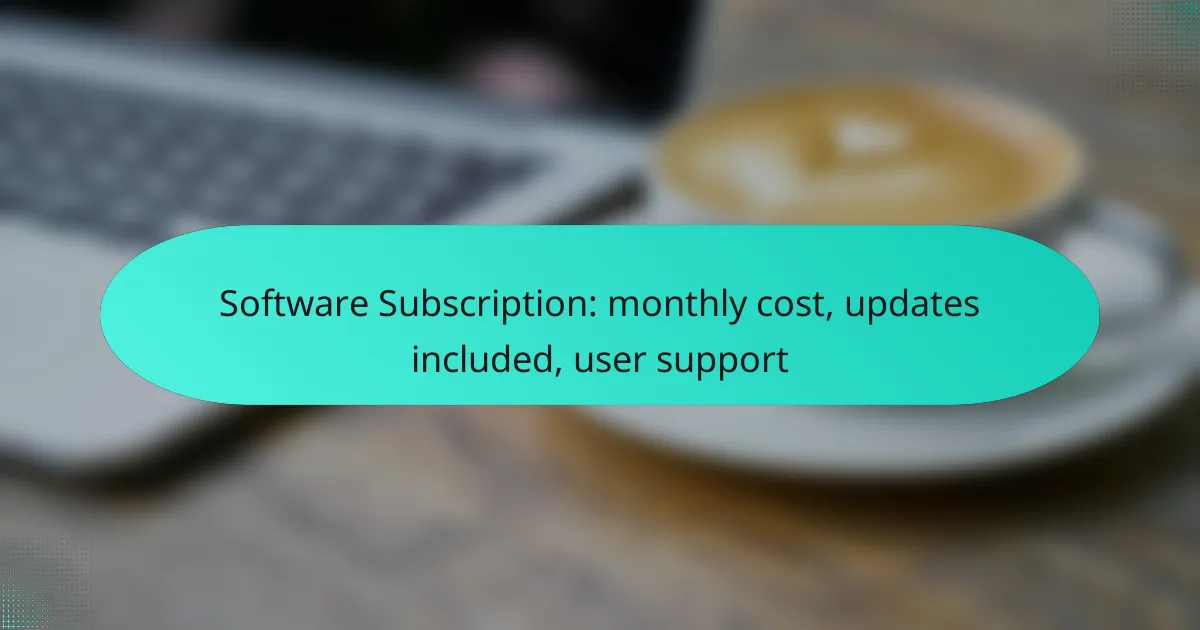Software subscriptions offer a flexible pricing model, with monthly costs in the UK ranging from £5 to over £100, depending on the software’s complexity and features. Subscribers benefit from regular updates that improve functionality and security, alongside access to user support through various channels like email, chat, and phone, ensuring a smooth and effective user experience.

What is the monthly cost of software subscriptions in the UK?
The monthly cost of software subscriptions in the UK can vary widely, typically ranging from £5 to £100 or more, depending on the type of software and its features. Basic applications may be available at lower prices, while advanced tools with extensive functionalities often come at a premium.
Average monthly cost for popular software
Common software subscriptions like Microsoft 365 and Adobe Creative Cloud usually fall within the £10 to £50 range per month. For instance, Microsoft 365 Personal is around £7 per month, while Adobe Creative Cloud can start at approximately £50 per month for individual apps.
Other popular tools, such as project management software like Trello or Asana, often offer tiered pricing, starting from free versions to paid plans that can cost between £10 and £30 monthly, depending on the features included.
Factors influencing subscription pricing
Additionally, the type of user support provided—such as 24/7 assistance or dedicated account managers—can also affect costs. Regular updates and new features may justify a higher subscription fee, making it essential to evaluate what is included in the plan before committing.

What updates are included in software subscriptions?
Software subscriptions typically include a range of updates that enhance functionality, security, and user experience. These updates can vary by provider but generally encompass new features, bug fixes, and security patches.
Types of updates provided
Common types of updates in software subscriptions include feature updates, which introduce new capabilities; security updates, which address vulnerabilities; and maintenance updates, which fix bugs and improve performance. Some subscriptions may also offer major version upgrades that significantly change the software’s functionality.
For example, a graphic design software might roll out a feature update that adds new design tools, while a productivity application may release a security update to protect user data. Understanding the types of updates included can help users maximize their software investment.
Frequency of updates in leading software
The frequency of updates can vary widely among software providers. Many leading software companies release updates on a monthly basis, while others may follow a quarterly or biannual schedule. Some applications, especially those in fast-moving sectors like cybersecurity, may offer updates even more frequently.
For instance, a popular cloud-based software might provide weekly updates to ensure users have the latest features and security enhancements. It’s essential to check the update policy of your software subscription to stay informed about when new updates will be available.

What user support is available for software subscriptions?
User support for software subscriptions typically includes various channels for assistance, such as email, chat, and phone support. These services help users resolve issues, get answers to questions, and make the most of their software experience.
Common support channels
Most software subscription services offer multiple support channels to cater to user preferences. Common options include email support, live chat, and telephone assistance. Some providers also have extensive online help centers with FAQs, tutorials, and community forums.
For example, a subscription service might provide 24/7 live chat support, while others may limit phone support to business hours. It’s essential to check the specific support options available for the software you are considering.
Response times for customer support
Response times for customer support can vary significantly based on the channel used and the provider’s policies. Email responses may take anywhere from a few hours to a couple of days, while live chat often yields quicker replies, typically within minutes.
When evaluating software subscriptions, consider the expected response times for each support channel. Some companies promise quick resolutions, while others may have longer wait times, especially during peak hours. Always check user reviews for insights into real-world support experiences.

How to choose the right software subscription?
Choosing the right software subscription involves assessing your specific needs, budget, and the features offered. Consider factors such as monthly costs, included updates, and user support to ensure you select a service that aligns with your requirements.
Criteria for evaluating software subscriptions
When evaluating software subscriptions, start by examining the pricing structure. Monthly costs can vary significantly, typically ranging from low single digits to several hundred dollars, depending on the software’s complexity and features. Look for clear details on what is included in the subscription, such as updates, additional features, and user support.
Next, assess the quality of user support provided. Reliable customer service can be crucial, especially for complex software. Check if support is available via multiple channels, such as email, chat, or phone, and whether it is offered during business hours or 24/7.
Finally, consider the frequency and nature of updates. Regular updates can enhance functionality and security, so ensure the subscription includes automatic updates or easy access to the latest versions.
Comparison of top software subscription services
Comparing top software subscription services can help you make an informed decision. Look at popular options like Adobe Creative Cloud, Microsoft 365, and Salesforce. Each offers different pricing tiers, typically starting from around $10 to $50 per month for basic plans, with advanced features costing more.
For instance, Adobe Creative Cloud includes regular updates and extensive user support, while Microsoft 365 emphasizes collaboration tools and cloud storage. Salesforce, on the other hand, is tailored for businesses and offers robust customer relationship management features, often at a higher price point.
Utilize comparison charts or tables to visualize differences in pricing, features, and support options, making it easier to identify which service best meets your needs.

What are the benefits of software subscriptions?
Software subscriptions offer flexibility and ongoing access to essential tools, making them an attractive option for many users. They typically include regular updates and user support, ensuring that subscribers can utilize the latest features without significant upfront costs.
Cost-effectiveness of subscriptions
Software subscriptions can be more cost-effective than traditional licensing models, especially for businesses and individuals who need to manage cash flow. Instead of a large one-time payment, users pay a smaller monthly or annual fee, which can range from a few dollars to several hundred, depending on the software.
Additionally, subscriptions often eliminate the need for costly upgrades, as updates are included in the subscription fee. This means users can avoid unexpected expenses and budget more effectively over time.
Access to the latest features
One of the key advantages of software subscriptions is the continuous access to the latest features and improvements. Subscribers receive updates automatically, ensuring they benefit from enhancements and new functionalities as soon as they are released.
This model allows users to stay competitive and take advantage of advancements in technology without the hassle of manual upgrades. For example, a graphic design software subscription might provide new design tools or templates every few months, enhancing user creativity and productivity.

What are the risks of software subscriptions?
Software subscriptions can pose several risks, including unexpected costs and long-term commitments that may not align with your needs. Understanding these risks helps users make informed decisions about their software investments.
Potential hidden costs
Many software subscriptions advertise low monthly fees, but hidden costs can quickly add up. These may include charges for additional features, premium support, or even fees for exceeding usage limits.
For example, a cloud storage service might offer a basic plan for $10 per month, but additional fees for extra storage can increase the total cost significantly. Always read the fine print and consider potential add-ons when evaluating subscription options.
Long-term commitment concerns
Software subscriptions often require a commitment that can last for months or even years, which may not be ideal for every user. If your needs change, you might find yourself locked into a plan that no longer serves you.
Additionally, some subscriptions offer discounts for annual payments, which can pressure users to commit long-term without fully assessing the software’s ongoing value. Consider starting with a monthly plan to evaluate the software before making a longer-term commitment.

What trends are shaping the future of software subscriptions?
Software subscriptions are increasingly influenced by emerging technologies, changing consumer preferences, and evolving business models. Key trends include the rise of cloud-based services, the integration of artificial intelligence, and a focus on user-centric features.
Emerging technologies in software delivery
Emerging technologies are transforming how software is delivered and consumed. Cloud computing allows for seamless updates and scalability, enabling users to access software from anywhere with an internet connection. This shift reduces the need for extensive local installations and maintenance.
Artificial intelligence is enhancing user experiences by providing personalized recommendations and automating routine tasks. For instance, AI-driven analytics can help businesses understand usage patterns, leading to more tailored subscription offerings. This technology not only improves efficiency but also increases customer satisfaction.
Another significant trend is the adoption of microservices architecture, which breaks down applications into smaller, manageable components. This approach allows for faster updates and easier integration of new features, making it more adaptable to user needs. Companies that embrace these technologies can remain competitive in a rapidly evolving market.
